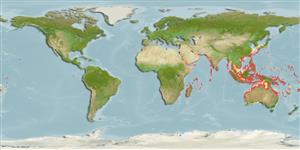Common names from other countries
Classification / Names / Names
Namen | Synonyme | Catalog of Fishes (gen., sp.) | ITIS | CoL | WoRMS
Environment: milieu / climate zone / depth range / distribution range
Ökologie
; tiefenbereich 1 - 50 m (Ref. 4), usually 1 - 8 m (Ref. 4). Tropical; 45°N - 37°S, 30°E - 171°W (Ref. 4)
Indo-West Pacific.
Length at first maturity / Size / Gewicht / Alter
Maturity: Lm ?, range 4 - 7.86 cm Max length : 50.0 cm TL Männchen/unbestimmt; (Ref. 4); common length : 35.0 cm TL Männchen/unbestimmt; (Ref. 4)
It has a maximum total body length of 50 cm, but usually much smaller (30 to 35 cm) (Ref. 4). It is found in shallow, sometimes slightly turbid coastal waters, from 1 to 8 m depth, with a record of 50 m deep. It inhabits sandy and muddy substrates, sometimes on rocky bottoms, often near the mouth of rivers, but also on coral reefs (Ref. 4). Subtidal (Ref. 106854). Juveniles occur in holes and crevices which are partially covered by seagrass or macroalgae (Ref. 106919). It is solitary, may live in pairs and has been found in larger concentrations (Ref. 4). Omnivore (Ref. 116259).
Members of the order Decapoda are mostly gonochoric. Mating behavior: Precopulatory courtship ritual is common (through olfactory and tactile cues); usually indirect sperm transfer.
Holthuis, L.B. 1991. (Ref. 4)
IUCN Rote Liste Status (Ref. 130435)
CITES Status (Ref. 108899)
Not Evaluated
Not Evaluated
Nutzung durch Menschen
Fischereien: kommerziell
| FishSource | Sea Around Us
Tools
Internet Quellen
Estimates based on models
Preferred temperature
(Ref.
115969): 24.6 - 29.3, mean 28.4 (based on 3578 cells).
Widerstandsfähigkeit
hoch, Verdopplung der Population dauert weniger als 15 Monate. (K=0.57).
Verwundbarkeit
Moderate vulnerability (40 of 100).
